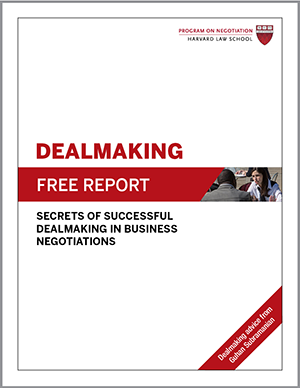
A good negotiation agent can be hard to find. Three New York art dealers and a Russian billionaire learned that lesson the hard way in negotiations over the sale of a painting by Leonardo da Vinci, as reported by Bloomberg and the New York Times.
The strange saga began in 2005, when the three dealers paid about $10,000 in an estate auction for a badly damaged painting of Jesus Christ believed to be a 16th-century work from Leonardo’s school.
One of the dealers, Old Masters specialist Robert Simon, brought the painting to art restorer Dianne Modestini in New York. Over the course of several years, Modestini painstakingly removed the varnish and overpainting of previous restoration attempts to reveal what she came to believe was Leonardo’s lost Salvator Mundi, or Savior of the World—a great lost work of art. Curators at New York’s Metropolitan Museum of Art authenticated the discovery. The Mundi, whose first owner was believed to have been King Charles of England, had fallen in and out of sight over the centuries before being mistakenly sold as the work of another artist for just 45 pounds at Sotheby’s London in 1958.
One painting, two stories
After the painting was restored, Simon and his colleagues lent it to museums while spreading the word that it was for sale. The director of the Dallas Museum of Art badly wanted to buy the painting. But with the sellers asking for $150 million, the two sides remained too far apart on price, and the Mundi returned to New York, according to Bloomberg.
Then, in quick succession, two potential buyers emerged: (1) a Russian billionaire and (2) a client of Sotheby’s, Swiss art dealer Yves Bouvier, who was anonymous to the sellers. The sellers set up two separate appointments.
Working on behalf of the sellers, Sotheby’s insured the Mundi for $150 million. Bouvier arranged for a Sotheby’s representative, Samuel Valette, to show the painting to him and another man at one of New York’s most expensive apartments. Sotheby’s says that it didn’t know the identity of the man who was with Bouvier; nor did the painting’s sellers.
As it turns out, that other man was the billionaire who had already scheduled a separate viewing of the Leonardo, Dmitry Rybolovlev, and the lavish apartment was his home. Rybolovlev, who has amassed one of the world’s most valuable art collections, had frequently hired Bouvier as an art adviser. And Bouvier had offered to help Rybolovlev buy the Leonardo through Sotheby’s, including by advising him on price.
In fact, Bouvier reportedly planned to first buy the Leonardo himself through Sotheby’s, while hiding his identity from the sellers as an anonymous buyer. At the same time, Bouvier represented himself to Rybolovlev as his negotiation agent, allegedly tricking him into thinking that he, Rybolovlev, was buying the painting through Sotheby’s.
The art of the deal
Having seen the painting with Bouvier, Rybolovlev canceled his own scheduled viewing. The sellers thought he had dropped out of the bidding, not knowing that he thought he was buying the painting through Bouvier. That left the sellers with just Sotheby’s anonymous buyer—Bouvier.
In price negotiations in Paris that April, a mysterious agent for the anonymous buyer (Bouvier) reportedly “hammered the sellers,” driving them down from their latest asking price of $100 million, according to Bloomberg. The parties settled on $80 million, the bulk of which Bouvier paid in cash, plus a $3 million commission for Sotheby’s.
Unbeknown to the three art dealers who had just sold the Mundi, Bouvier was already scheming to resell the painting to Rybolovlev—who thought he was buying it through Sotheby’s with Bouvier acting as his negotiation agent. According to an email filed in court by Rybolovlev’s lawyers, Bouvier lied to a Rybolovlev representative that he had offered the sellers $100 million for the Leonardo on behalf of Rybolovlev but that they had turned him down “without a moment’s hesitation.” Bouvier ended up convincing Rybolovlev to pay $127.5 million—$47.5 million more than Bouvier had paid for it himself just days earlier. Rybolovlev thought he bought the painting from the trio of sellers, through Sotheby’s, when in fact he bought it from Bouvier.
Scratching beneath the surface
After Bouvier was caught allegedly flipping the Mundi, the trio of sellers were not only angry with him but also suspicious of Sotheby’s. Bouvier was a valued client of the auction house. Had Sotheby’s known of Bouvier’s plans to resell the painting for a much higher price?
Rybolovlev had similar questions. The Mundi was just one of 38 paintings his family’s trust had purchased through Bouvier, 12 of them through Sotheby’s. The billionaire has said he thought Bouvier was acting as his agent, earning a 2% commission, only to learn that he had previously skimmed up to $1 billion by buying the paintings himself and reselling them to Rybolovlev with hefty markups. Rybolovlev filed criminal charges against Bouvier in Monaco, where Bouvier was arrested in 2015 and freed on bond, the Times reports.
Denying all the accusations against him, Bouvier has said he is free to charge whatever the market will bear for a painting. Furthermore, he said that Sotheby’s didn’t know about his relationship with Rybolovlev and that the billionaire was far too sophisticated a collector to be conned into significantly overpaying for artwork, according to Bloomberg.
A private matter blows up
As for the painting’s trio of sellers, they have accused Sotheby’s of colluding with Bouvier. In court papers filed in November 2016 to try to block a lawsuit, Sotheby’s claimed it hadn’t known of its anonymous buyer’s plans to flip the Leonardo for a much higher price.
In a statement, the three art dealers who sold the Mundi accused Sotheby’s of trying to “spin their egregious behavior in the face of media scrutiny.” The dealers noted that 20 months after the sale, Sotheby’s had provided Bouvier with an insurance appraisal that valued the Leonardo at $113 million, closer to the price Rybolovlev paid than to the price Bouvier negotiated. Another instance, in which Bouvier flipped a Gustav Klimt painting to Rybolovlev after buying it through Sotheby’s, also aroused their suspicions.
Insisting they had attempted to negotiate the matter in private, the dealers now say they will try to “correct” Sotheby’s “distortions” through court actions, including suing Sotheby’s for fraud to recover the millions more they might have earned from the sale.
2 tips to avoid being taken for a ride by a negotiation agent
1. Identify conflicts of interest. Clients often assume their agents’ financial incentives are perfectly aligned with their own, but that is rarely the case. Sotheby’s, for example, may have had an incentive to get a high price for the Leonardo’s sellers to increase its commission, but it also was motivated to keep Bouvier, a repeat client, satisfied. Before hiring an agent, scrutinize her likely incentives and determine whether they are closely aligned with your own.
2. Insist on transparency. The shadowy nature of sales in the art world allowed Bouvier to misrepresent himself and his intentions to art buyers and sellers alike. You can avoid being taken advantage of in negotiation by insisting that all parties, including agents, be willing to engage in a clear and transparent process.
What issues have you encountered when using a negotiation agent?





